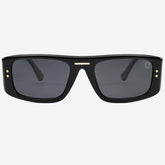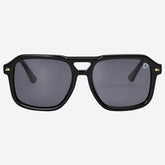How are eyeglasses lenses made?
Whenever the subject of eyeglass lenses is discussed, it is paramount that you pay extra attention as they are the tools through which millions see the world clearly. Did you know 60% of the world's population requires vision correction, and many of these diseases can be prevented by wearing the right lenses?
It's the reason we must learn how lenses are made so we can make informed choices and appreciate the skills and expertise of the technicians who manufacture them
Lenses have undergone many modifications since the Italian monks used them. Today, they are commonly made from plastic or glass disks and are cut, polished, and coated to fit a specific size and prescription. In this article, you'll learn the process, materials and machines used to make eyeglass lenses.
What materials are used to make eyeglass lenses

Plastics
These lenses are the most suitable for those with light prescriptions, ranging from no correction to +/_1.75. They are the most affordable and are lightweight. They are recommended for those with a mild to medium single-vision prescription. Plastics are not shatter-resistant but have good UV coating and optical qualities.
Polycarbonate
The polycarbonate is shatter-resistant with a suitable thickness and weight. It is 30% lighter and thinner in weight than plastic. They suit those with a prescription of +_2.00 to +_ 4.00. Its impact resistance makes it a good option for children less than 18 and active lifestyle wearers with mild to moderate prescriptions.
They have UV filters that block Ultraviolet rays and are recommended for producing safety glasses. They are suitable for rimless frames; polycarbonate lenses can be easily drilled and resist cracking around the drill holes.
Trivex
Trivex is the lightest lens material and offers superior optic quality. It has an abbe value of [ 43-45], which gives it better optical clarity and fewer chromatic aberrations. It is shatter-resistant, has an inherent UV blockage, and can be easily tinted. It is suitable for 3-piece or semi-rimless glasses.
High index
Index refers to how thick a lens material is. High-Index lenses are made from plastic but have a high refractive index, which helps bend light and improve vision.
You should use a high-index lens if your prescription is high due to nearsightedness, farsightedness, or astigmatism. High Index lenses are available in two thicknesses, 1.67 and 1.74. Both are made from the same plastic material, but High-Index 1.74 lenses are thinner and work better in stronger prescriptions
What are the machines used to produce eyeglass lenses?

Lens cutting machine
The lens cutting machine uses computer-controlled precision to cut lenses from large plastic sheets or glasses accurately. It shapes the lens blank to the essential curvature and ensures lenses meet the prescription.
Blocking Machine
Before cutting and shaping the lenses, they must be stabilized. The blocking machine uses special adhesives to attach the lens blank to a block. This block holds the blank firm during the surfacing process[ production of lenses]
Fining Machines
After generating the shape, the finning machine smoothes the lens surface. It involves finer grinding to remove rough areas and prepare the lens for polishing.
Polishing Machines
The polishing machines give the lens a clear finish. Polishing removes dirt and imperfections, ensuring smooth, clear surfaces.
Step-by-step process to making eyeglass lenses?

1 Vision analysis
The process begins with a visit to the eye care specialist or optometrist. They will measure your prescription and create a unique vision profile that details specific requirements for correcting vision issues such as myopia (nearsightedness), hyperopia (farsightedness), astigmatism, and presbyopia.
2 Lens Blank selection
Lens blanks are pieces of lens materials that have not been shaped yet. The blanks are chosen based on your measurements and prescription and are available in plastics, polycarbonate, or high-index plastics.
3 Blocking
The lens is mounted on special adhesives or chunks to allow for accurate work. The block provides precision and stability during the cutting and grinding process.
4 Generating
The lens is then cut to a rough shape with a laser or diamond-tipped tool through a process called "generating." This step removes the bulk of the material to create the general curvature needed for the prescription. The process takes 90 seconds and allows for customization to specific vision needs.
5 Polishing/ Finishing.
After the generating process, the lens is polished and smoothed. It involves finer polishing/grinding to remove marks or imperfections that stayed after the generating process to give a clear and smooth surface. In this stage, the lens could be engraved with small marks for lens identification and proper frame orientation.
6 Deblocking
Deblocking removes the lens from the block, and proper cleaning removes any specks of dirt, adhesives, or polishing compounds. The lens can be cleaned with brushes, cleaning agents, and ultra-pure (i.e., especially well-treated) water, which can remove dirt from the lens in preparation for coating. The lenses are then blow-dried. During production, sustainability is key. Materials like metal alloy should be treated and reused, and the water for production should be recycled in an eco-friendly manner.
7 Tinting [ if applicable]
At this stage, the lenses are tinted on request. Layers. Tinting can range from light cosmetic colors to darker shades for sunglasses. Textile colors are environmentally and human-friendly. However, this process demands experience and skills to make each tint unique.
8 Coating
Various coatings like UV- -protection,anti-reflective, and scratch-resistant coatings) can be applied to the lens. They enhance the longevity and performance of the lens. The coating makes the lens repel dirt, reduces annoying reflection, scratches,and ensures crystal-clear vision and UV-blocking rays. Temperatures are regulated during the coating for even distribution and adherence to the lens surface.
9 Quality assurance
The finished lenses undergo a rigorous inspection by our technicians at Dollger to ensure they meet the prescribed specifications of our quality standards. This involves a visual check to ensure accurate power, thickness, and alignment and no defects in the material or coatings.
10 Glazing (Inserting into Frames):
In the final step, the lenses are carefully inserted into the eyeglass frames, ensuring they fit perfectly without any stress that could affect vision. The optician will make final adjustments to the frames to ensure a comfortable fit for the wearer. The completed glasses are adjusted to fit the wearer comfortably, including fine-tuning the frame arms and nose pads. The optical centers of the lenses are aligned with the wearer's pupils to ensure optimal.
How are stock and semi Lenses made?

Stock and semi-finished lenses made of plastic are crafted with care using a unique casting process. Quality ingredients capable of blocking harmful UV rays are mixed into the liquid materials called monomers.
The mixture is poured into molds, allowing it to set and become firm. After that, it undergoes a gentle process to ease residual stress, and the semi-finished lens is now ready. A hard coating will be applied to get the stock lens. And if desired, more coatings can be added for extra charm.
The process for semi-finished lenses made of glass is different. First, natural materials, like potassium carbonate, quartz, and soda, are melted in an oven at a temperature of 1400°-1500°c to create a glass mixture a few centimeters thick, known as pressing. Next, the front surface is gently shaped using a diamond grinding tool to achieve its perfect form, while a delicate polishing step gives it the transparency it needs.
What is the future of eyeglass lens manufacturing

The future of eyeglass lens manufacturing is evolving with significant advancements in technology, sustainability, and smart eyewear:
Sustainability
The eyeglass industry is moving towards more sustainable manufacturing processes. The industry is titling to reduce the use of plastics, enhancing water conservation, and adopting greener energy sources.
Technology and Customization
Freeform technology has revolutionized eyeglass lens manufacturing, allowing for more precise and customized optical surfaces. Innovations include improved material diversity, such as the use of high-index plastics and photochromic lenses and advancements in coatings for scratch resistance, clarity, and easy cleaning. Additionally, integrating digital technologies allows lenses to be more tailored to individual lifestyles, with unique designs for different activities and health considerations.
Smart Eyewear
There is a growing trend towards smart glasses, incorporating augmented reality (AR) and other digital features. Despite initial setbacks with products like Google Glass, companies such as Apple, Facebook, Amazon, and Snap continue to invest and develop smart eyewear, indicating a belief that these devices could represent the future of personal technology. These glasses offer new functionalities beyond traditional eyewear, merging digital information with the physical world.
Conclusion
The process of making eyeglass lenses is an intricate and highly specialized field that combines art, science, and technology. From the selection of materials, each step is crucial for delivering clear and accurate vision to users. It's the reason we assembled a professional team that ensures every lens produced is flawless.
Whether you require lenses for vision correction, protection, or aesthetic purposes, understanding the meticulous process behind their creation can help you make informed choices and appreciate the craftsmanship that goes into every pair.





